AUDI S4 2015 Owners Manual
Manufacturer: AUDI, Model Year: 2015, Model line: S4, Model: AUDI S4 2015Pages: 304, PDF Size: 74.86 MB
Page 91 of 304
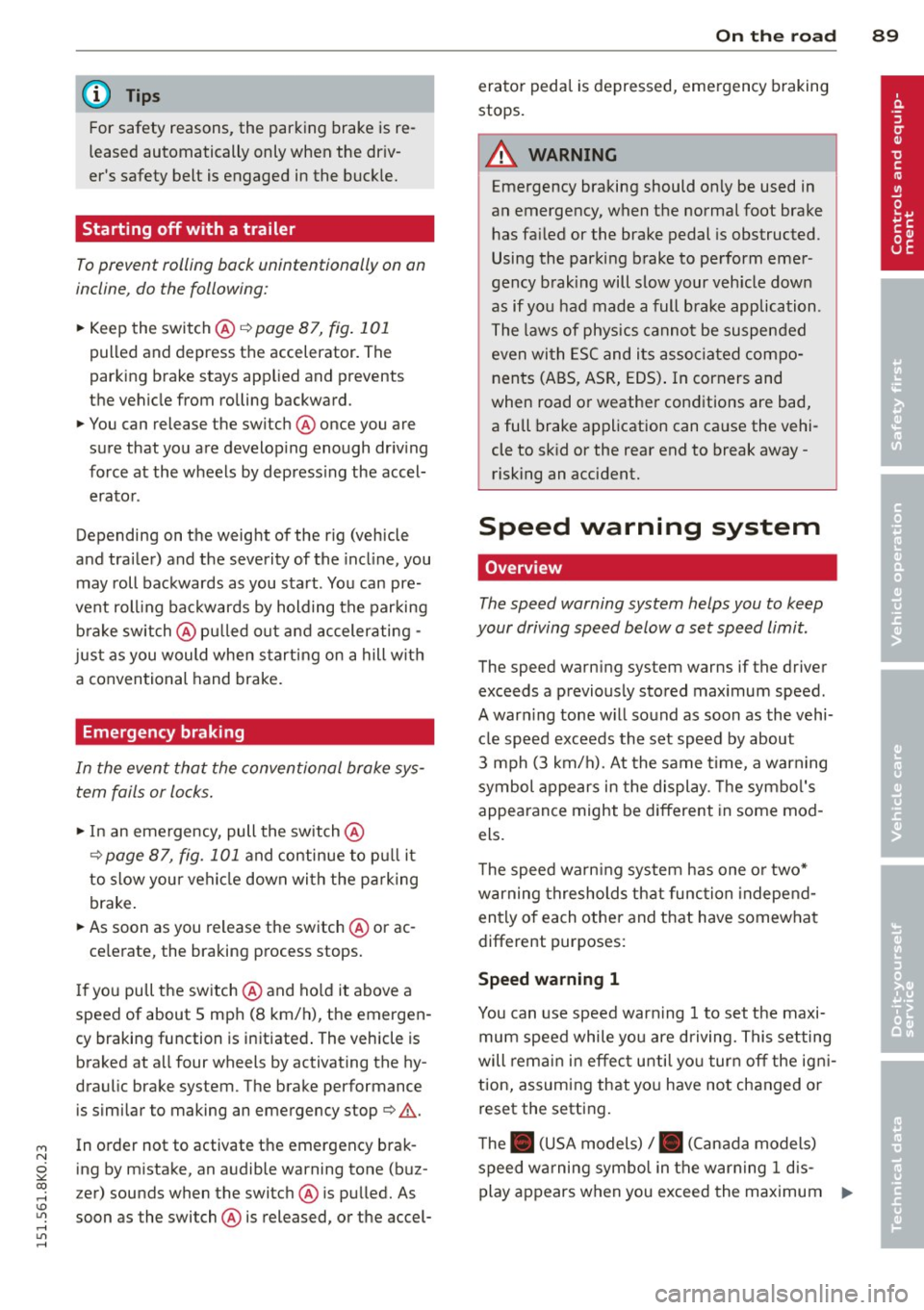
"' N
0 ::.,: co ,...., \!) ..,.,
,...., ..,., ,....,
@ Tips
For safety reasons, the par king brake is reĀ
leased au tomatically only when the dr ivĀ
er 's safety belt is engage d in the buckle.
Starting off with a trailer
To prevent rolling back unintentionally on an
incline , do the following:
~ Keep the switch @Ā¢ page 87, fig . 101
pulled and depress the accelerator. The
park ing brake stays app lied and prevents
the vehicle from rolling backward.
~ You can release the switch @once you are
sure that you are develop ing enough dr iv ing
force at the wheels by depress ing the accelĀ
erator .
Depending on the weight of the r ig (vehicle
and trailer) and the severity of the incl ine, you
may roll backwards as you start . You can preĀ
ve nt rolling backwards by holding the parking
b rake sw itch @pulled out and accelerating -
jus t as you would whe n starting on a hill with
a conventional hand brake.
Emergency braking
In the event that the conventional brake sys Ā
tem fails or locks.
~ I n an eme rgency, pull the sw itch @
Ā¢page 87, fig. 101 and continue to p ull it
to s low your vehi cle down wi th the pa rk ing
brake .
~ As soon as you release the switch @ or ac-
ce lerate, the braking process stops.
I f you pull the switch @and ho ld it above a
speed of about 5 mph (8 km/h), the emergen Ā
cy braking function is initiated . The vehicle is
braked at a ll four wheels by activating the hyĀ
draulic brake system. T he brake performance
is similar to making an emergency stop Ā¢
&. .
In order not to activate the emergency brak Ā
ing by m istake, an a udible warning tone (buzĀ
zer) sounds when the switch @is pulled. As
soon as the switch @ is released, or the accel-
On th e ro ad 89
erator peda l is depressed, eme rgency braking
stops.
A WARNING
Emergency braking should only be used in
an emergency, when the norma l foot brake
has fa iled or the brake pedal is obstructed.
Using the parking brake to perform emerĀ
gency b rak ing will slow your vehicle down
as if you had made a full bra ke application .
T he laws of physics cannot be suspended
even with ESC and its asso ciated compoĀ
nents (ABS, ASR , EDS) . In corners and
when road or weathe r conditions are bad,
a full brake application can ca use the vehiĀ
cle to sk id or the rear end to break away -
risking an accident.
Speed warning system
Overv iew
The speed warning system helps you to keep
your driving speed below a set speed limit.
The speed warn ing system warns if the driver
exceeds a previous ly stored max imum speed.
A war ning tone w ill so und as soon as the vehiĀ
cle speed exceeds the set speed by about 3 mph (3 km/h). At the same time, a warn ing
symbol appears in the display. The symbo l's
appearance might be different in some mod Ā
els.
T he speed wa rn ing system has one or two*
warning thresholds that func tion independ Ā
en tly of each othe r and that have somewhat
different purposes:
Speed warning 1
You can use speed warn ing 1 to set the maxiĀ
mum speed while you are d riving. This se tting
will re ma in in effec t unti l yo u t urn
off the ig niĀ
tion, assuming that yo u have no t changed or
reset the setting.
T he . (USA models)/ . (Canada models)
speed wa rning sym bol in the warn ing 1 dis-
play appears w hen you exceed the maximum ..,.
Page 92 of 304
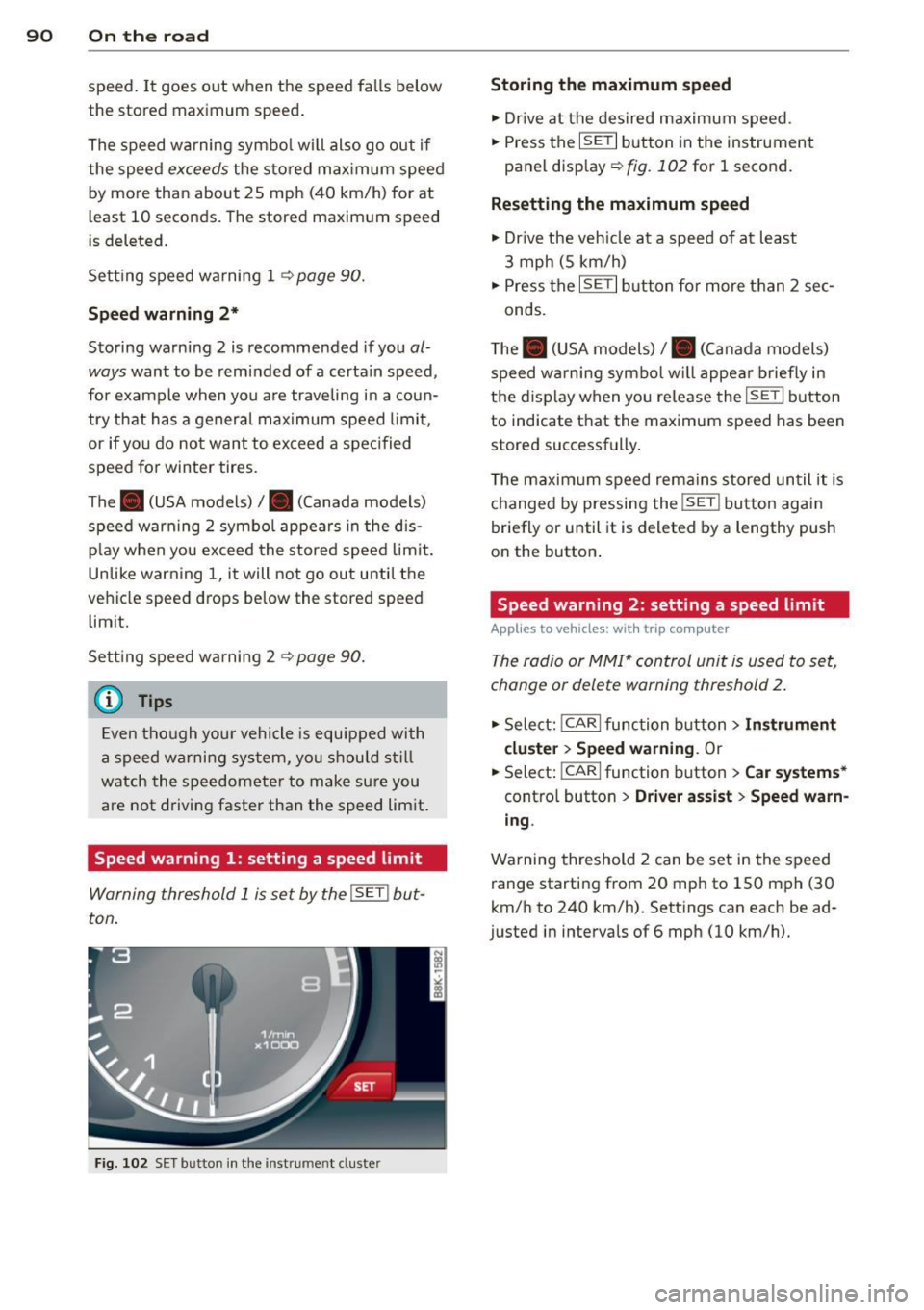
90 On the road
speed. It goes out when t he speed fa lls below
the stored maximum speed .
The speed warning symbo l w ill also go out if
the speed
exceeds the s to red m ax imum speed
by more than about 25 mph ( 40 km/h) for at
least 10 seconds. The stored maximum speed
is deleted.
Sett ing speed wa rning 1
~ page 90.
Speed warning 2*
Storing warning 2 is recommended if you alĀ
ways
want to be reminded of a certa in speed,
for examp le when you a re traveling in a counĀ
try that has a general maximum speed limit,
or if you do not want to ex ceed a spec ified
speed for winter tires.
The . (USA models) /. (Canada mode ls)
speed warning 2 symbo l appears in the disĀ
p lay when you exceed the stored speed limit .
Unlike warning 1, it will not go out until t he
vehicle speed drops below the stored speed
limit.
Sett ing speed wa rning 2
~ page 90.
@ Tips
Even tho ugh your vehicle is equipped wi th
a speed wa rni ng sys tem, you s hou ld s till
watch the speedometer to make sure you
are not drivi ng faster than the speed limit.
Speed warning 1 : setting a speed limit
Warning threshold 1 is set by the I SET ! butĀ
ton .
Fig. 102 SET button in the inst rum en t cluste r
Storing the ma ximum speed
.,. Dr ive at the desired maximum speed .
.,. Press the
ISETI button in the instrument
panel display ~
fig. 102 for 1 second.
Resett ing the maximum speed
.,. Dr ive the veh icle at a speed of at least
3 mph (5 km/h)
.,. Press the
I SET I but ton for more than 2 sec-
onds.
T he . (USA models)/ . (Canada models)
speed w arning symbo l w ill appe ar briefly in
the d isplay when you release the
ISETI button
to indicate t hat the maximum speed has been
stored successfully .
T he maxim um speed remai ns stored un til it is
changed by pressing the
! SE T! button again
briefly or until it is deleted by a lengthy push
on the button .
Speed warning 2: setting a speed limit
Applies to veh icles: w it h trip co mputer
The radio or MMI* control unit is used to set,
change or delete warning threshold 2.
.,. Sele ct: !CAR I func tion button > Instrument
cl uster > Speed warnin g.
Or
.,. Select:
!CARI function button > Car system s*
contro l button > Dri ver a ssist > Speed warnĀ
ing .
Warning threshold 2 can be set in the speed
range starting from 20 mph to 150 mph (30
km/h to 240 km/h) . Settings can each be adĀ
justed in intervals of 6 mph (10 km/h).
Page 93 of 304
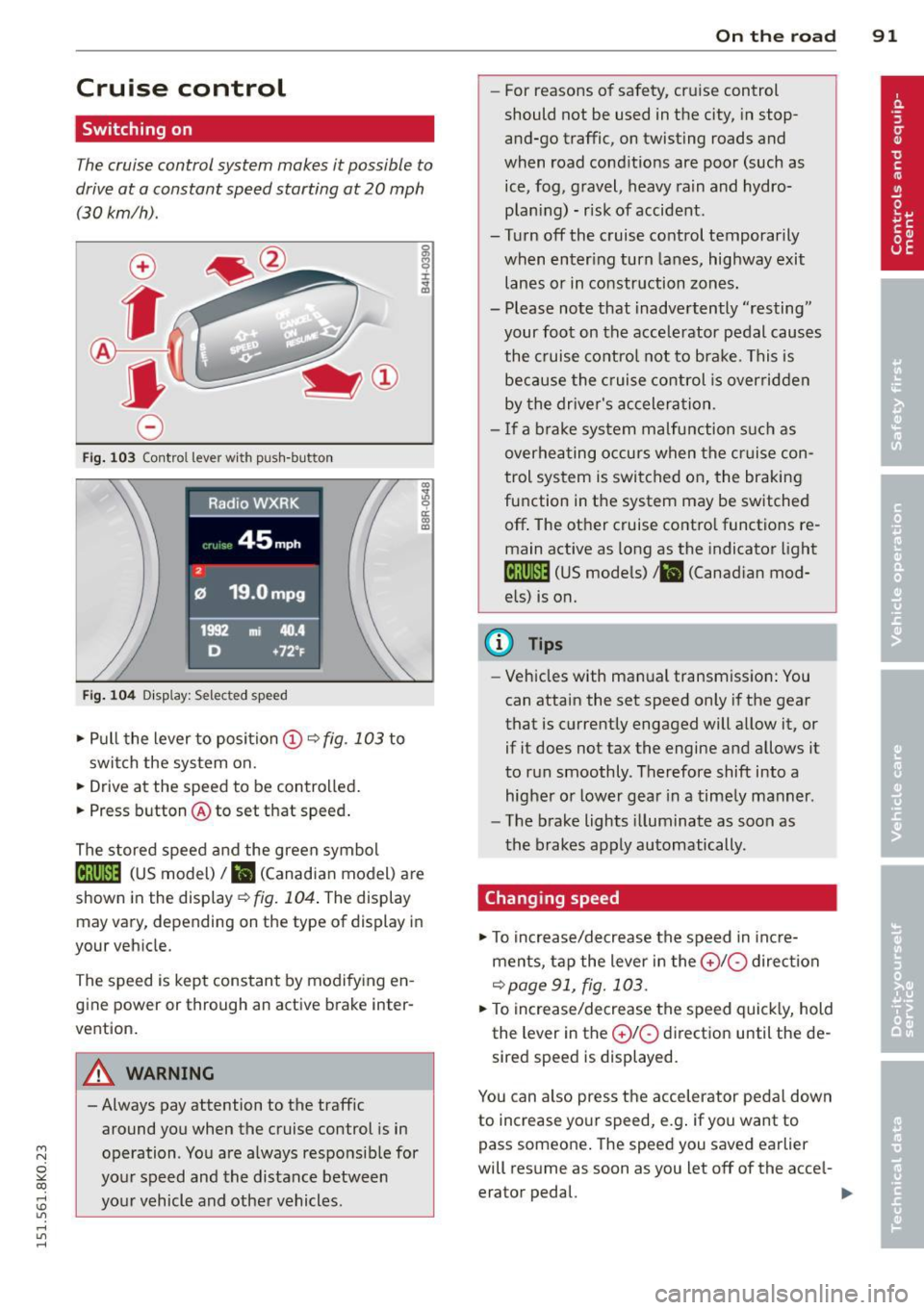
M N
~ co
rl I.O
"' rl
"' rl
Cruise control
Switching on
The cruise control system makes it possible to
drive at a constant speed starting at 20 mph (30 km/h).
0
f
~
0
Fig . 103 Contro l lever wi th push-but ton
Fig . 104 Display: Se lected speed
.,. Pull the lever to position(!)~ fig. 103 to
swit ch the system on.
.,. Drive at the speed to be controlled.
.,. Press button @ to set that speed .
.,
;1; 9 a: .,
"'
The stored speed a nd the green symbol
[ij;(i )~14 (US model)/ .. (Canadian model) are
shown in the display~
fig. 104 . The display
may vary, depending on the type of display in
your vehicle.
The speed is kept constant by modifying enĀ gine power or through an active brake interĀ
vention.
A WARNING
- Always pay attention to the traffic around you when the cruise control is in
operation . You are always responsib le for
your speed and the distance between
your vehicle and other vehicles.
On th e road 91
-For reasons of safety, cruise control
should not be used in the city, in stopĀ
and-go traffic, on twisting roads and
when road conditions are poor (such as ice, fog, gravel, heavy ra in and hydroĀ
plan ing) -risk of accident .
- Turn off the cruise control temporarily when enter ing turn lanes, highway exit
lanes or in construction zones.
- Please note that inadvertently ''resting" your foot on the accelerator pedal causes
the cruise control not to brake. This is
because the cruise control is overridden
by the driver's accelera tion.
- I f a brake system malfunction such as
overhea ting occurs when the cruise conĀ
trol system is switched on, the braking
function in the system may be switched
off . The other cruise contro l functions reĀ
main active as long as the indicator light
lij;(i )~14 (US models) ;a (Canad ian modĀ
els) is on.
(D Tips
- Vehicles with manual transmission: You
can attain the set speed only if the gear
that is currently engaged will allow it, or
if it does not tax the engine and allows it
to run smoothly . Therefore shift into a
higher or lower gear in a timely manner .
- The brake lights illuminate as soon as
the brakes apply automatically.
Chang ing speed
.,. To increase/decrease the speed in increĀ
ments, tap the lever in the
0 10 direction
~ page 91, fig.103 .
.,. To increase/decrease the speed quick ly, hold
the lever in the
0 10 direction until the deĀ
sired speed is displayed.
You can also press the accelerator pedal down
to increase your speed, e.g . if you want to
pass someone . The speed you saved earlier
will resume as soon as you let off of the acce l-
erator pedal. .,..
Page 94 of 304
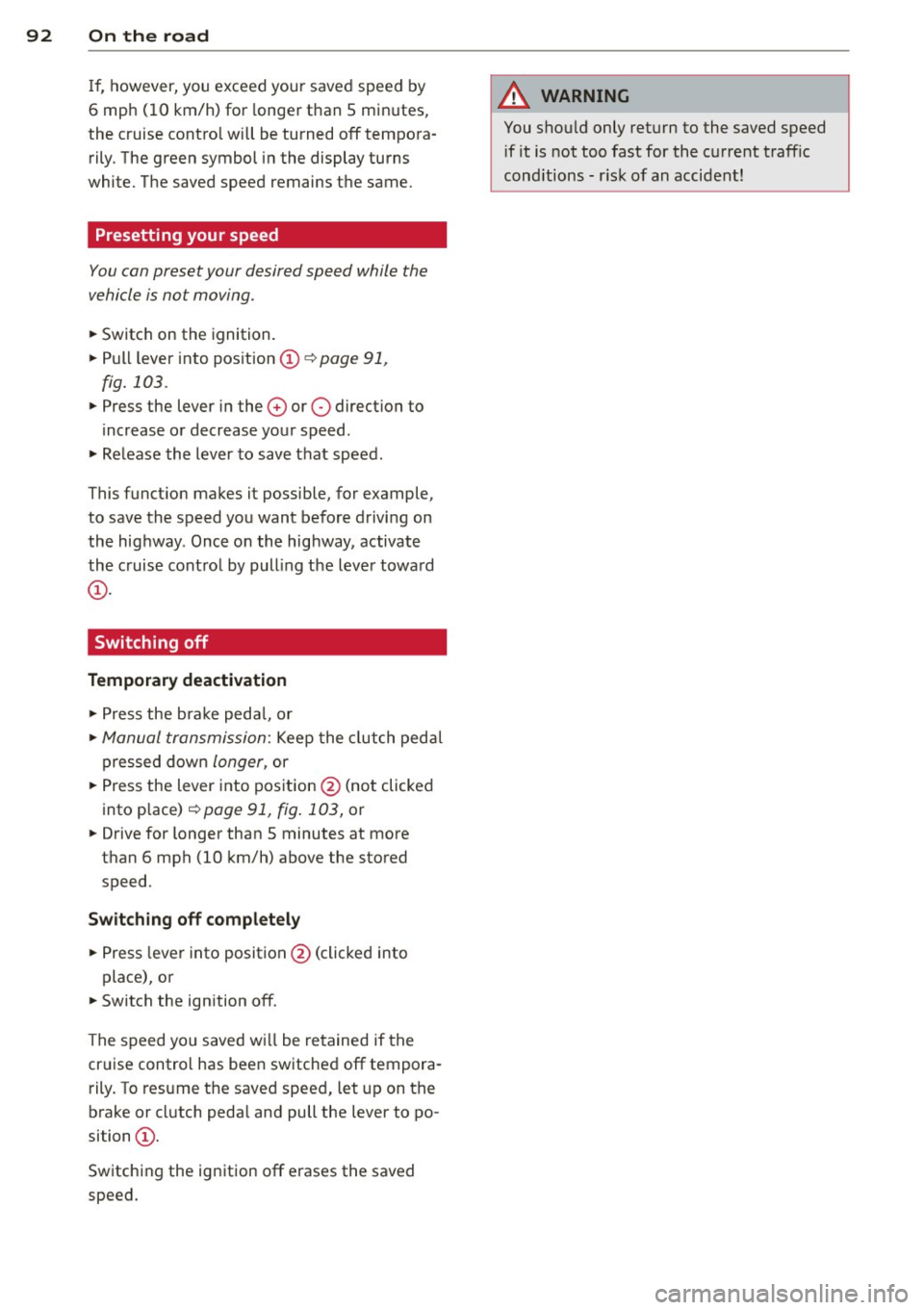
92 On the road
If, however, you exceed your saved speed by
6 mph (10 km/h) for longer than 5 minutes,
the cruise contro l will be turned off temporaĀ
rily. The green symbol in the display turns
white. The saved speed remains the same.
Presetting your speed
You can preset your desired speed while the
vehicle is not moving .
.. Switch on the ignition .
.. Pull lever into position @Ā¢
page 91,
fig. 103 .
.. Press the lever in the 0 or 0 direction to
increase or decrease your speed .
.. Release the lever to save that speed .
This funct ion makes it possible, for example,
to save the speed you want befo re driving on
the hig hway . Once on the hig hway, activate
the cruise cont ro l by pull ing the lever towa rd
@ .
Switching off
Temporary deactivation
ā¢ Press the bra ke peda l, or
ā¢ Manual transmission : Keep the clutch ped al
pressed down
longer , or
.. Press the lever into position @ (not clicked
into p lace)
c:> page 91, fig . 103, or
.. Drive for longer than 5 minutes at more
t h an 6 mph (10 km/h) above the stored
speed.
Switching off completely
.. Press leve r into position @(clicked into
place), o r
.. Switch the ign ition off.
The speed yo u saved w ill be re tained if the
cr uise control has bee n switched off tempora Ā
rily. To resume the saved speed, let up on the
brake or cl utch peda l and pull the lever to poĀ
si tion @.
Switching the ignition off erases the saved
speed.
A WARNING
You shou ld only return to the saved speed
i f it is not too fast for the current traffic
conditions - r isk of an accident!
Page 95 of 304
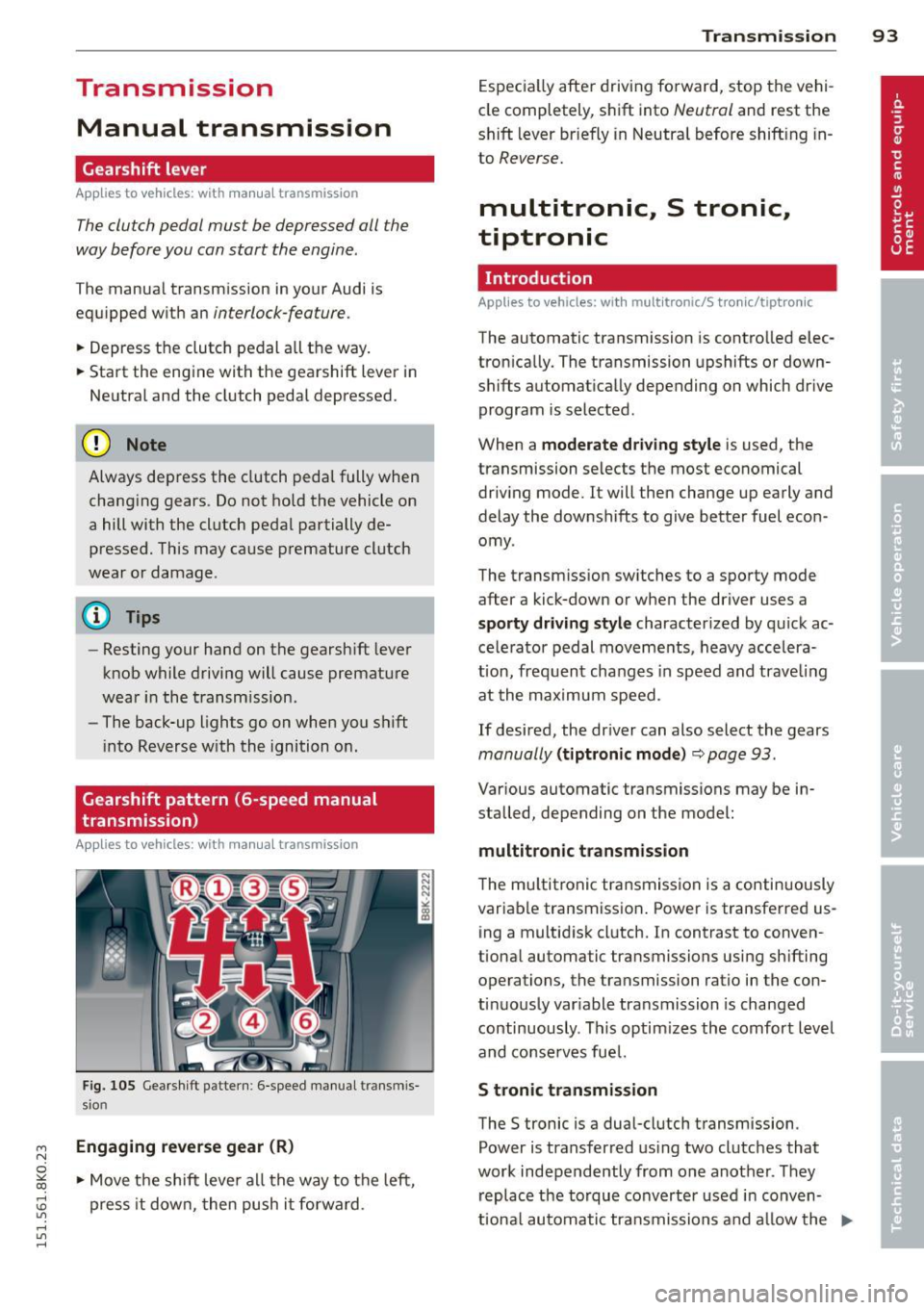
M N
~ co
rl I.O
"' rl
"' rl
Transmission Manual transmission
Gearshift lever
App lies to vehicles: with manual transmission
The clutch pedal must be depressed all the
way before you can start the engine.
T he manual transmission in your Audi is
equipped with an
interlock-feature.
~ Depress the clutch pedal all the way.
~ Start the eng ine with the gearshift lever in
Neutral and the clutch pedal depressed.
(D Note
Always depress the clutch pedal fully when
changing gears . Do not hold the vehicle on
a hill with the clutch pedal partially deĀ
pressed. This may cause premature clutch
wear or damage .
@ Tips
-Resting your hand on the gearshift lever
knob while driving will cause premature
wear in the transmission.
- The back-up lights go on when you shift
into Reverse w ith the ignition on.
Gearshift pattern (6-speed manual
transmission)
Applies to vehicles: with manual transmission
Fig. 105 Gearshift pattern : 6-speed manual transmisĀ
sio n
Engaging reverse gear (R)
~ Move the shift lever all the way to the left,
press it down, then push it forward . Transmission
93
Especially after driving forward, stop the vehiĀ
cle completely, shift into
Neutral and rest the
shift lever br iefly in Neutral before shift ing inĀ
to
Reverse.
multitronic., S tronic.,
tiptronic
Introduction
Applies to vehicles: with multitronic/S tronic/tiptronic
The automatic transmission is controlled elec Ā
tronically. The transmission upshifts or downĀ
shifts automatically depending on which drive
program is selected .
When a
moderate driving style is used, the
transmission selects the most economical
driving mode. It will then change up early and
delay the downshifts to give better fuel econ Ā
omy .
The transmission switches to a sporty mode
after a kick-down or when the driver uses a
sporty driving style characterized by quick acĀ
celerator pedal movements, heavy acceleraĀ
t ion, frequent changes in speed and trave ling
at the maximum speed.
If desired, the driver can also select the gears
manually (tiptronic mode)~ page 93 .
Various automatic transmissions may be inĀ
stalled, depending on the model:
multitronic transmission
The multitronic transmission is a continuously
variable transmission. Power is transferred usĀ
ing a multidisk clutch. In contrast to convenĀ
tional automatic transmissions using shifting
operations, the transmission ratio in the conĀ
tinuously var iable transmission is changed
continuously . This optimizes the comfort level
and conserves fuel.
S tronic transmission
The S tronic is a dual-clutch transmission .
Power is transferred using two clutches that
work independently from one another_ They
replace the torque converter used in convenĀ
tiona l automatic transmissions and allow the ..,_
Page 96 of 304
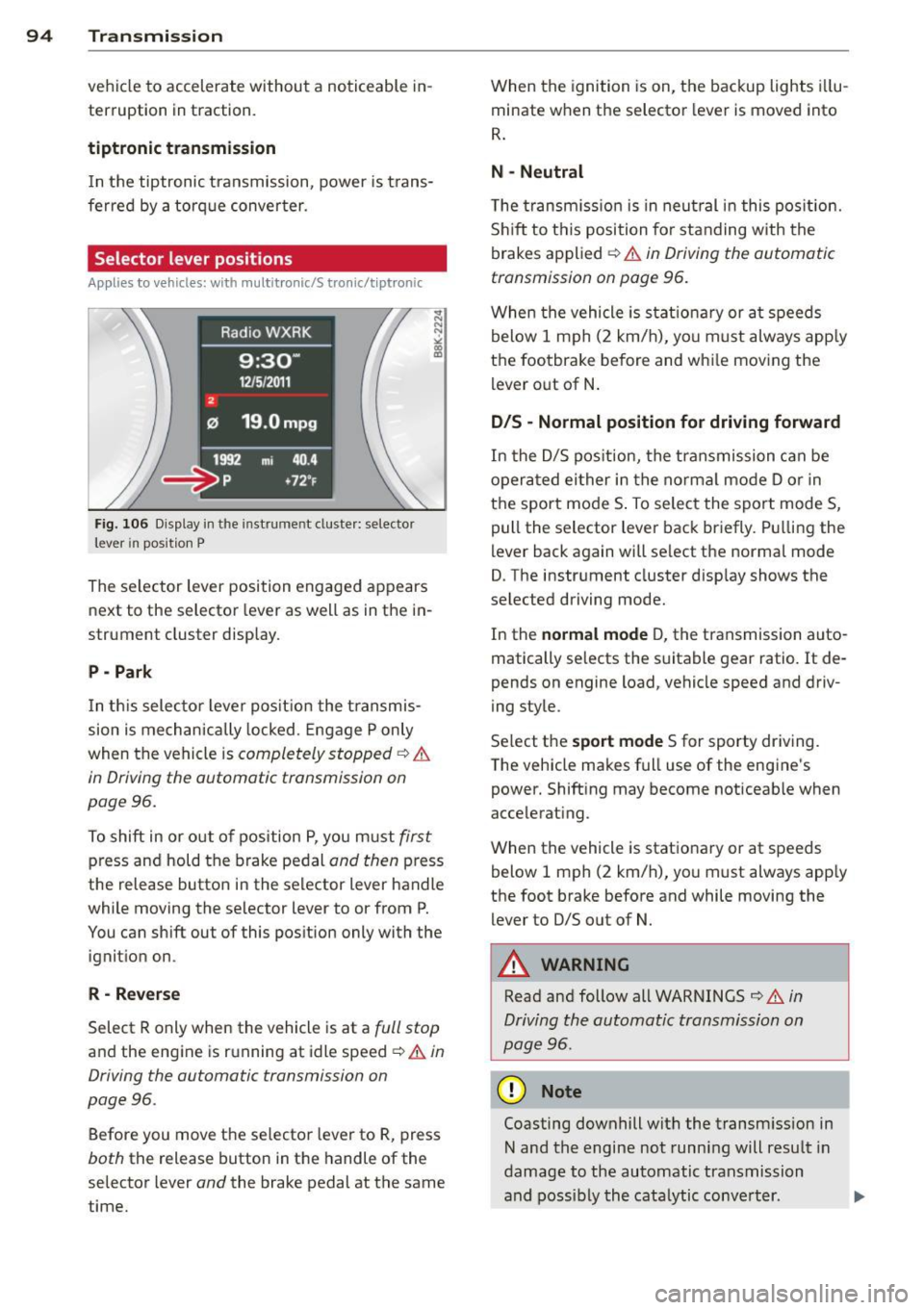
94 Transmi ssion
vehicle to accelerate without a noticeable inĀ
terruption in traction.
tiptronic tran smission
In the tiptronic transmission, power is transĀ
ferred by a torq ue converter.
Selector lever positions
Applies to vehicles: with multitronic/5 tronic/tiptronic
Fig. 106 D isplay in the instrume nt duste r: selector
lever in position P
The se lector lever position engaged appears
next to the selector lever as well as in the inĀ
strument cluster display.
P - Park
In th is selector lever pos it ion the transmisĀ
sion is mechanically locked. Engage P only
when the vehicle is
completely stopped Ā¢ &
in Driving the automatic transmission on
page 96.
To shift in or o ut of pos ition P, you must first
press and hold the brake pedal and then press
the release button in the selector lever handle
while moving the se lector lever to or from P.
You can shift out of this position only with the ignition on .
R-Re verse
Select R only when the vehicle is at a full stop
and the engine is running at idle speed Ā¢ & in
Driving the automatic transmission on
page 96.
Before you move the selector lever to R, press
both the release button in the handle of the
selector lever
and the brake pedal at the same
time. When the
ignition is on, the backup lights i llu Ā
minate when the selector lever is moved into
R .
N -Neutral
The transm iss io n is in neut ral i n this pos ition.
S hi ft to this position fo r standing with the
brakes applied Ā¢
& in Driving the automatic
transmission on page 96.
When the vehicle is stat ionary or a t speeds
below 1 mph (2 km/h), yo u must always app ly
the footbrake before and whi le moving the
lever o ut of N .
D/S - Normal position for driving forward
In the D/S pos ition, the transmission can be
opera ted ei ther in the norma l mode D or in
the sport mode S . To select the sport mode S,
pull the selector lever back briefly. P ulling the
lever back again will se lect the normal mode
D. The instrument cluster disp lay shows the
selected driving mode.
In the
normal mode D, the transmission autoĀ
matically selects the suitable gear ratio.
It deĀ
pends on engine load, vehicle speed and drivĀ
ing style.
Se lect the
s port mode S for sporty dr iving.
T he vehicle makes full use of the engine's
power. Shift ing may become noticeable when
acce lerating.
When the vehicle is stationary or at speeds below 1 mph (2 km/h), you must always app ly
the foot brake before and while moving the lever to D/S out of N.
A WARNING
Read and follow all WARNINGS Ā¢ .& in
Driving the automatic transmission on
page 96 .
(D Note
Coasting downhill with the transm ission in
N and the engine not running will result in
damage to the automatic transmission
and possibly the cata lytic conve rter. .,..
Page 97 of 304
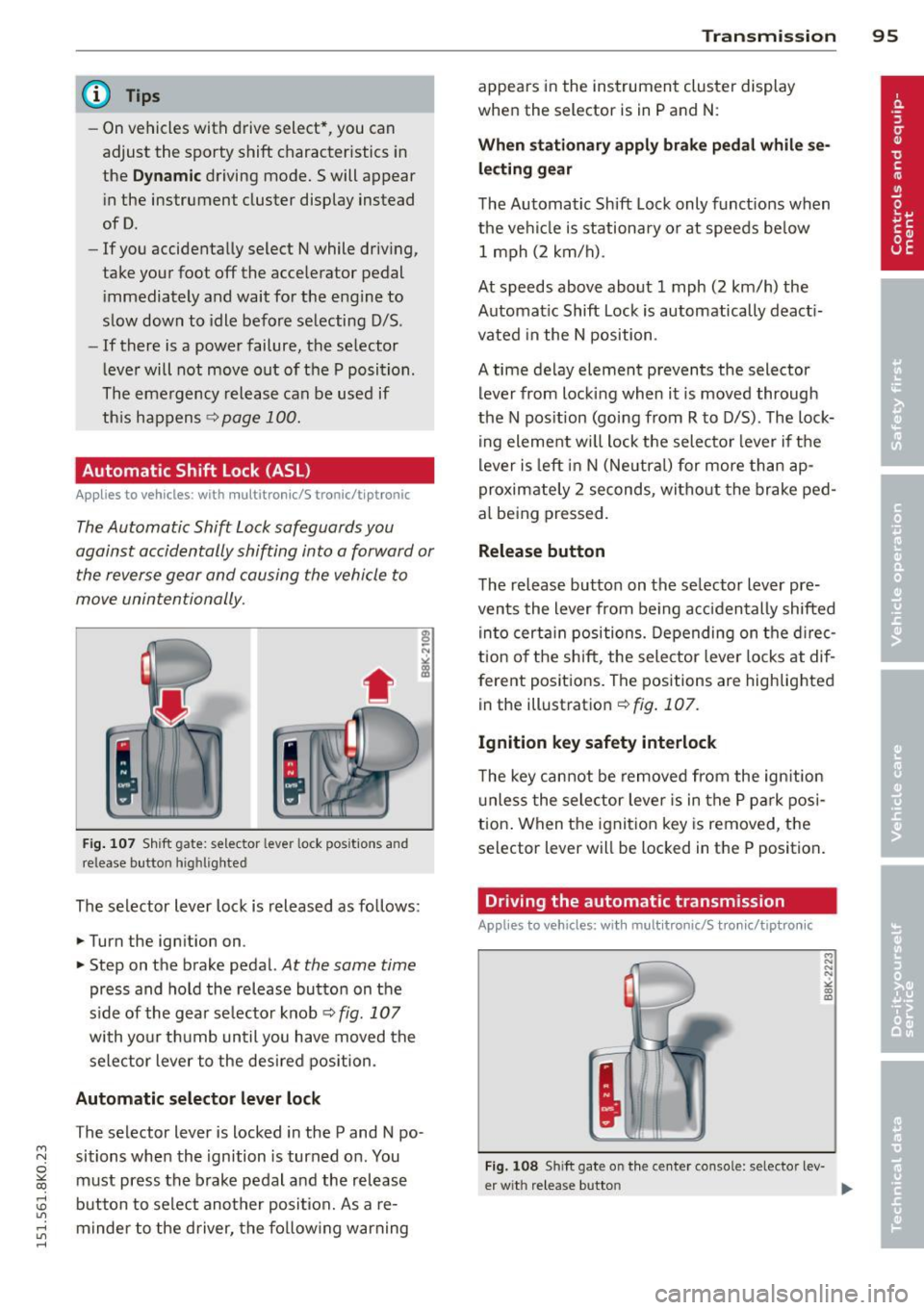
M N
~ co
rl I.O
"' rl
"' rl
@ Tips
-On vehicles with drive select*, you can
adjust the sporty shift characteristics in
the
Dynamic driving mode.Swill appear
i n the instrument cluster display instead
ofD.
- If you accidentally select N while driv ing,
take your foot off the acce lerator pedal
i mmediately and wait for the engine to
s low down to idle before selecting D/S.
- If there is a power failure , the selector
l ever will not move out of t he P position .
The eme rgency release can be used if
th is happens ~
page 100.
Automatic Shift Lock (ASL)
Applies to vehicles: with multitronic/5 tronic/tiptron ic
The Automatic Shift Lock safeguards you
against accidentally shifting into a forward or
the reverse gear and causing the vehicle to
move unintentionally.
F ig. 10 7 Sh ift gate: selecto r lever lock posit io ns and
release butto n highlighted
The selector lever lock is released as fo llows:
... Turn the ign ition on .
... Step on t he brake pedal.
At the same time
press and hold the release button on the
side of the gea r se lector knob Ā¢
fig. 107
with yo ur t hu mb until you have moved the
sele ctor lever to the des ired position .
Automatic selector lever lock
The selector lever is locked in the P and N poĀ·
sitions when the ignition is turned on . You
must press the brake pedal and the release
button to select another posi tion. As a reĀ·
m inder to the driver, the fo llow ing warning
Transm ission 95
appears in the ins trument cluster display
whe n the selector is in P and N:
When stationary appl y brake pedal while se Ā
lec ting gear
The Automatic Shift Lock only funct ions when
the ve hicl e is stationary or at speeds be low
1 m ph (2 km/h) .
At speeds above about 1 mph (2 km/h) the
Automat ic Shift Lock is automatically deact iĀ
vated in the N position .
A time delay element prevents the selector lever from lock ing when it is moved through
the N pos ition (going from R to D/S) . The lockĀ
ing element w ill lock t he selec to r l ever if the
lever is left in N (Neutr al) for more than apĀ
proximate ly 2 seconds, wi tho ut the brake pedĀ
al being pressed.
Release button
The release button on the se lector lever preĀ
vents the lever from be ing acciden tally shifted
in to certa in positions. Depending on the d irecĀ
t ion of the shift, the sele ctor leve r locks at difĀ
ferent positions. The positions are highlig hted
in the illust rationĀ¢
fig . 107.
Ignition key safety interlock
T he key cannot be removed from the ign ition
u nless the selector lever is in the P par k posiĀ
tion . When the ignit ion key is removed, the
selector lever will be loc ked in the P position .
Driving the automatic transmission
Applies to vehicles; with mult itronic/S tronic/tiptronic
Fig. 108 Sh ift gate on the ce nter console: selector lev-
er w it h re lease butto n ..,_
Page 98 of 304
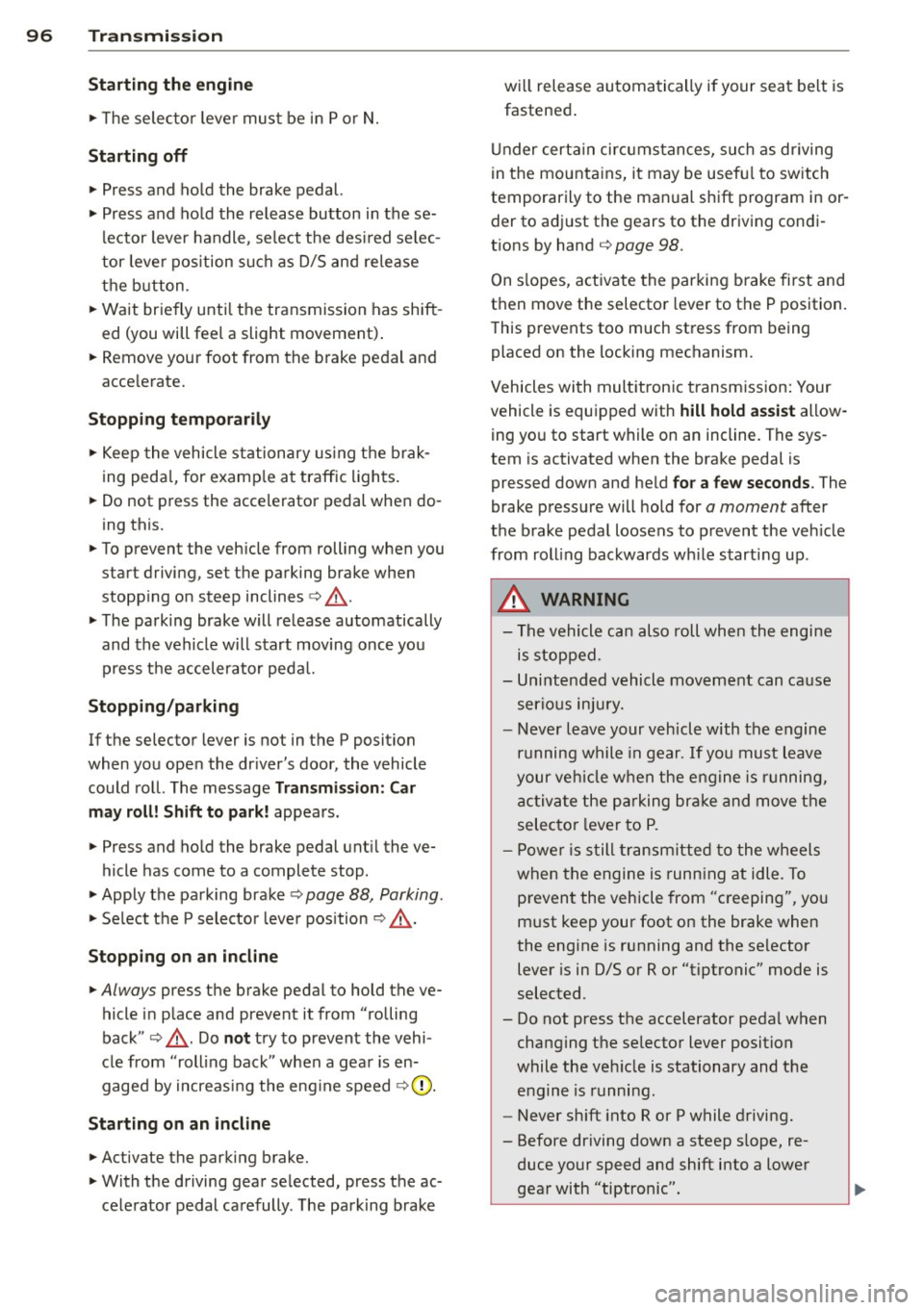
96 Transmission Starting the engine
.. The selecto r lever must be in P or N.
Starting off
.. Press and hold the brake pedal.
.. Press and hold the release button in theseĀ
lector lever handle, se lect t he des ired selecĀ
tor lever position such as D/S and release
the button .
.. Wait briefly unti l the transmission has shift Ā
ed (you will feel a slight movement) .
.. Remove your foot from the brake pedal and
acce lerate.
Stopping temporarily
.. Keep the vehicle stationary usin g the brakĀ
ing peda l, for examp le at traffic lights .
.. Do not press the accelerator pedal when doĀ
ing this .
.. To prevent the veh icle from rolling when you
start driving, set the parking brake when
stopping on steep inclines
c> _& .
.. The parking brake will release automatically
and the vehicle w ill start moving once you
press the accelerator pedal.
Stopping/parking
If the selector lever is not in the P position
when you open the dr iver's door, the vehicle
could roll. The message
Transmission: Car
may roll! Shift to park!
appears.
.. Press and hold the brake pedal until the ve-
hicle has come to a complete stop .
.. Apply the parking brake
c> page 88, Parking .
.. Select the P selector lever position c> _&.
Stopping on an incline
.. Always press the brake pedal to hold the veĀ
hicle in place and prevent it from "rolling
back"
c> _& . Do not try to prevent the vehiĀ
cle from "roll ing back" when a gear is enĀ
gaged by increasing the eng ine speed
c> (D.
Starting on an incline
.. Activate the parking brake.
.. With the driving gear se lected, press the acĀ
celerator pedal carefully. The park ing brake will release automatically if your seat
belt is
fastened .
Under certain circumstances, such as driving
in the mo untains, it may be usefu l to switch
temporarily to the manual shift program in orĀ
der to adjust the gears to the driving cond iĀ
tions by hand
c> page 98.
On slopes, activate the parking brake first and
then move the selector lever to the P position .
This prevents too much stress from being
placed on the locking mechanism .
Vehicles with multitronic transmission: Your
vehicle is equipped with
hill hold assist allowĀ
ing you to start while on an incline. The sysĀ
tem is activated when the brake pedal is
pressed down and he ld
for a few seconds . The
brake pressure will hold for
a moment after
the brake pedal loosens to prevent the vehicle
from roll ing backwards wh ile starting up .
A WARNING
-The vehicle can also roll when the engine
is stopped.
- Unintended vehicle movement can cause
serious injury.
- Never leave your vehicle with the engine
r un ning while in gear. If you must leave
your veh icle when the engine is running,
activate the parking brake and move the
selecto r lever to P.
- Power is still transmitted to the wheels
when the engine is running at idle. To
prevent the vehicle from "creeping", you
must keep your foot on the brake when
the engine is running and the selector
lever is in D/S or R or "tiptronic" mode is
selected .
- Do not press the accelerator pedal when changing the selector lever position
while the veh icle is stationary and the
engine is running.
- Never shift into R or P while driving.
- Before driving down a steep s lope, re-
duce your speed and shift into a lower
gear with "tiptronic".
Page 99 of 304
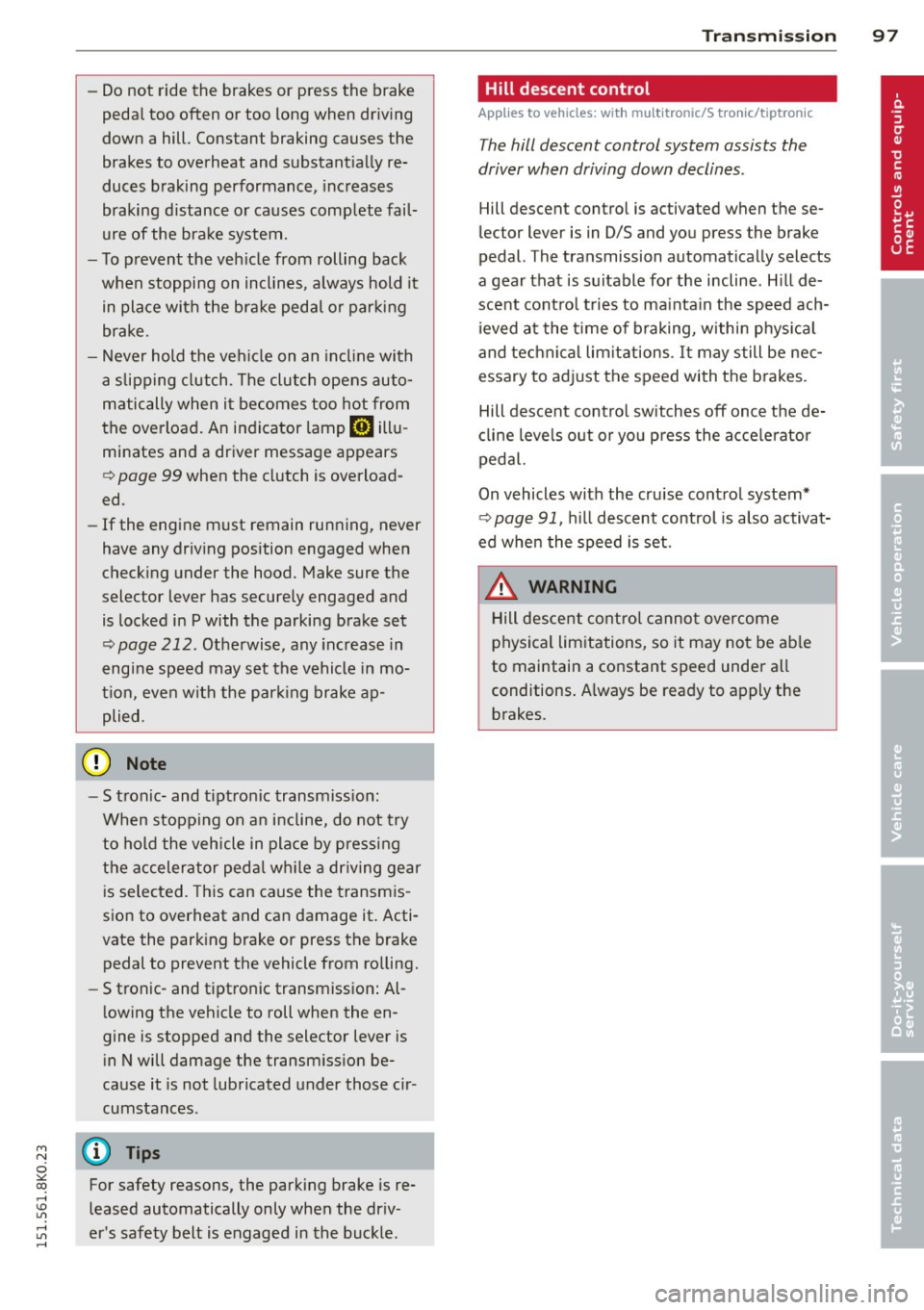
"" N
0 ::.,: co ,...., \!) 1.1'1 ,...., 1.1'1 ,....,
-Do not ride the brakes or press the brake
pedal too often or too long when driving
down a hill. Constant braking causes the
brakes to overheat and substantially reĀ
duces braking performance, increases
braking distance or causes complete failĀ
ure of the brake system.
- To prevent the vehicle from rolling back
when stopping on inclines, always hold it
in place with the brake pedal or parking
brake.
- Never hold the vehicle on an incline with
a slipping clutch. The clutch opens autoĀ
matically when it becomes too hot from
the overload. An indicator lamp
mJ illuĀ
minates and a driver message appears
Ā¢ page 99 when the clutch is overloadĀ
ed .
- If the engine must remain running, never
have any driving position engaged when
checking under the hood. Make sure the
selector lever has securely engaged and
is locked in P with the parking brake set
Ā¢ page 212. Otherwise, any increase in
engine speed may set the vehicle in moĀ
tion, even with the parking brake apĀ plied .
0 Note
-S tronic- and tiptronic transmission:
When stopping on an incline, do not try
to hold the vehicle in place by pressing
the accelerator pedal while a driving gear
is selected. This can cause the transmisĀ
sion to overheat and can damage it. ActiĀ
vate the parking brake or press the brake
pedal to prevent the vehicle from rolling.
- S tronic- and tiptronic transmission: AlĀ
lowing the vehicle to roll when the enĀ
gine is stopped and the selector lever is in N will damage the transmission beĀ
cause it is not lubricated under those cirĀ
cumstances .
(D Tips
For safety reasons, the parking brake is reĀ
leased automatically only when the driv Ā
er's safety belt is engaged in the buckle.
Transmission 97
Hill descent control
App lies to vehicles : wi th mult itronic/ S tro nic/tiptro nic
The hill descent control system assists the
driver when driving down declines .
Hill descent control is activated when theseĀ
lector lever is in D/S and you press the brake
pedal. The transmission automatically selects
a gear that is suitable for the incline. Hill deĀ scent control tries to maintain the speed achĀ
ieved at the time of braking, within physical
and technical limitations. It may still be necĀ
essary to adjust the speed with the brakes.
Hill descent control switches off once the deĀ
cline levels out or you press the accelerator
pedal.
On vehicles with the cruise control system*
Ā¢ page 91 , hill descent control is also activatĀ
ed when the speed is set.
.&_ WARNING
-
Hill descent control cannot overcome
physical limitations, so it may not be able
to maintain a constant speed under all
conditions. Always be ready to apply the brakes .
Page 100 of 304
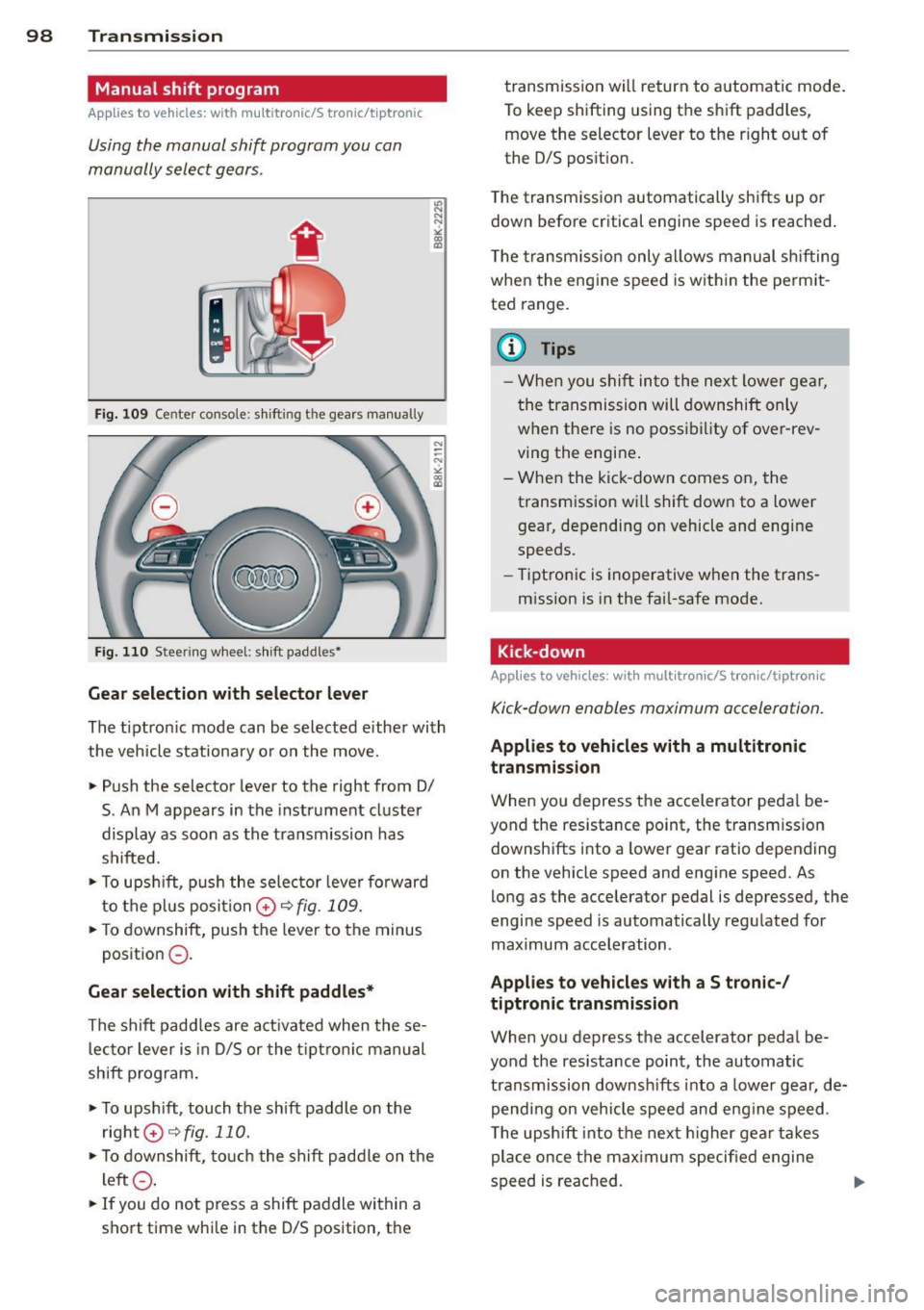
98 Transmission
Manual shift program
Appl ies to vehicles: with multitronic/5 tronic/t iptronic
Using the manual shift program you can
manually select gears .
Fig . 10 9 Center co nsole: s hifti ng t he gears manu ally
Fig . 110 Stee ring w hee l: shi ft paddle sā¢
Gear selection with selector lever
"' N
N
~
" a> CD
The tiptron ic mode can be selected e ither with
the vehicle stationa ry or on the move.
ā¢ Push the selector lever to the right from 0/
S. An M appears in the instrument cl uster
display as soon as the transmission has
shifted.
ā¢ To u pshi ft, p ush the selec tor leve r forward
to the pl us posi tion
0 r:::, fig . 109.
ā¢ To downshift, push the leve r to the minus
p osit ion
0 -
Gear selection with shift paddles*
The s hift padd les are a ct ivated when theseĀ
l ec to r lever is in 0/5 or the t ip tron ic manu al
shift program .
ā¢ To ups hift, touch the shift paddle on the
right G)Ā¢fig.110.
ā¢ To downshift, touch t he shift p add le on t he
l eft
0 .
ā¢ If you do not press a shift pa ddle within a
sho rt time whi le in the 0/5 position, t he transmission will return to a
utomatic mode .
To keep shifting using t he sh ift paddles,
move the selector lever to the r ight out of
the 0/5 pos ition.
T he transm iss io n automatically sh ifts up or
down before critical engine speed is reached .
T he tra nsm iss io n only a llows m anual sh ifting
when the eng ine speed is w it hi n the pe rm it Ā
ted range .
@ Tips
- When you s hift into the ne xt l ower ge ar,
the transmissi on will downshift only
w hen the re is no poss ib ility of ove r-revĀ
ving the engine .
- W hen the kic k-down comes on, the
transm ission w ill shift dow n to a lower
gear, depending on vehicle and engine
speeds .
- Tip tro ni c is inoperative when the trans Ā
m ission is in the fai l-safe mode .
Kick-down
Applies to vehicles : wit h mult itronic/5 t ro ni c/tip tro nic
Kick-down enables maximum acceleration.
Applies to vehicles with a multitronic
transmission
W hen you depress the accelerator peda l be Ā
yond the res istance point, the transm ission
downsh ifts into a lower gear ratio depend ing
on the vehicle speed and engine speed. As
lo ng as the accelerator pedal is depressed, the
engine speed is automatically regu lated for
maximum acceleration .
Applies to vehicles with a S tronic-/
tiptronic transmission
When you depress the accelerator peda l beĀ
yond the resistance point, the automatic transmission downsh ifts into a lowe r gear, deĀ
pend ing on veh icle s peed an d eng ine speed .
T he upsh ift into t he nex t higher gea r takes
place once the max imum speci fied engine
s p eed is reached.